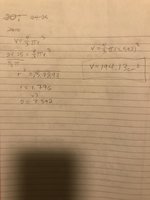I got another problem. And I wanna make sure I’m doing this right.
There’s no context again, just write formula and solve.
Problem: “The ratio of volume of two spheres is equal to the ratio of the cubes of their diameters. The volume of one sphere is 24.25 cm3. Find the volume of another sphere whose diameter is twice as much.”
here’s what I got so far...

There’s no context again, just write formula and solve.
Problem: “The ratio of volume of two spheres is equal to the ratio of the cubes of their diameters. The volume of one sphere is 24.25 cm3. Find the volume of another sphere whose diameter is twice as much.”
here’s what I got so far...

